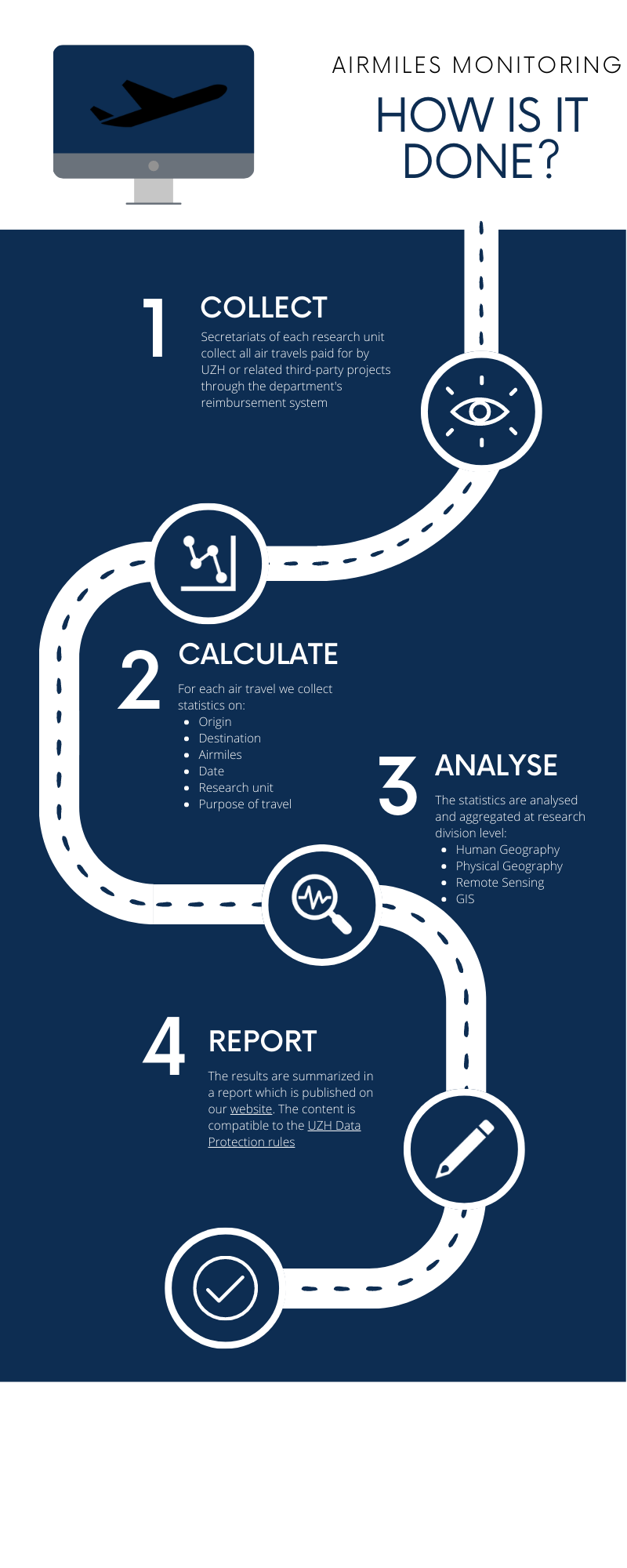Airmiles monitoring: How it is being done at GIUZ
In coordination with the GIUZ Executive Board, the airmiles group has developed a concept for airmiles monitoring and has put forward reduction goals. Both have been regularly updated based on discussions within the GIUZ Sustainability Task Force and external experts.

New approach to air travel statistics from 2021 onwards |
EmissionsUntil 2020, the division secretariats manually queried airmiles/kilometres and CO2 equivalents from Atmosfair. In 2021, we automated this process, retrieving the CO2 equivalents from the GoClimate Flight Emissions API. Both services yield comparable but slightly different emission estimates. For example, Atmosfair estimates 2’235 to 3’855 kg of CO2 emissions for an economy class round trip from Zurich (ZRH) to New York (JFK), depending on the airline. For the same trip, GoClimate estimates average emissions of 2’400 kg CO2. Flight distanceWe automatically compute the Haversine distance between each departure and arrival airport of each flight. The Haversine distance from Zurich (ZRH) to Lima (LIM) with a stopover in Madrid (MAD) equals 10’778 km, slightly below the 10’855 km manually retrieved from Atmosfair. Staff countThe GIUZ administration implemented a new method to count the Department staff, providing a harmonised baseline for evaluating per capita emissions and distance. AutomatizationSo far, the secretariats have manually queried flight distances and CO2 equivalents. Now, we automatically retrieve the emissions from the GoClimate Flight Emissions API and compute flight distances in R, reducing the workload on the secretariats and making the reporting reproducible and consistent. R scriptThe airmiles analysis is now available as a script in R markdown, with modular code chunks for each step (pre-processing, emission retrieval, statistical analysis, plotting), simplifying future airmiles analysis. |
Procedure for the years 2017-2020
Air travel is collected through the department’s reimbursement system by the division secretariats and evaluated by the working group. Thus far, we have collected air travel information from 2017 to now. The first three years (2017- 2019) build the reference period for monitoring and setting the reduction goals. The airmiles monitoring consist of the following steps:
- Data collection: The secretariats of each research unit collect all business air travels paid for by UZH or related third-party projects (including guests) through the reimbursement system.
- Air travel statistics: For each air travel, we collect statistics based on a standardised template, providing information about the route (e.g. origin, destination, airmiles, date), the research unit, and the purpose of travel.
- Data Analysis: We evaluate the air travel statistics. For data protection reasons, results are aggregated at the level of the research divisions.
- Reporting: We summarise the results in a short report for the attention of the GIUZ Direktorium and publish the report on our website. The content of the report is compatible to the UZH Data Protection rules.